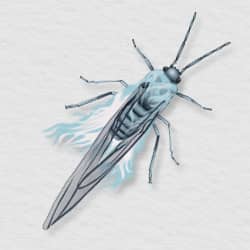Are you fortunate enough to have a beautiful Chinese hackberry tree around your home? These gorgeous and vibrant trees are a welcomed part of our attractive Tennessee outdoor scenery. They provide beauty and shade for many of us. Unfortunately, sometimes they can also bring a pest around that can be a sticky nuisance. The hackberry wooly aphid can make that wondrous tree of yours a bit of a problem if they decide to make it their home, especially if anything that you value happens to be underneath its branches. The honeydew substance that is covering everything under your hackberry tree is not from the tree itself, but from this aphid.
Hackberry wooly aphids are a tiny furry bug that is about 1/10 of an inch long. They appear to be fuzzy, bluish or white masses on the leaves. Some people say that it appears that there are bits of cotton or snow drifting through the air when clusters of them are moving between trees. Usually, the first sign of their presence is the sticky honeydew that they produce. This honeydew falls and adheres to anything underneath the branches of the tree. This honeydew build up can be slippery and sticky. Decks, porches, roofs, cars and anything that is unlucky enough to be stationed under an infested hackberry tree will be covered in it, often making the surfaces slippery and unsightly.
Hackberry wooly aphid adults, either winged or wingless have a very interesting life cycle. All throughout the seasons where hackberry leaves are present, spring and summer, these insects give live birth to reproductive females only. Then, in the fall, winged males are born and they mate with the females. The females lay eggs that overwinter on branch terminals (branch buds). In the spring, the eggs hatch as the tree produces leaves. These eggs are the females that will give live birth to the reproductive females and the cycle continues throughout another year. Depending on the area, seasonal temperatures and lengths, these insects can have several generations per year which means that their populations can quickly increase.
How do you keep them off your Chinese hackberry tree? Unfortunately, the services we provide may only provide short term relief rather than a long term, sustainable solution. A systemic treatment that gets into the root system of the tree works best. This year seems to have brought out the masses of wooley aphids- we have them every year… but this year is just worse. They will be gone no later than the first frost of the season.
 1270 Reviews
1270 Reviews


